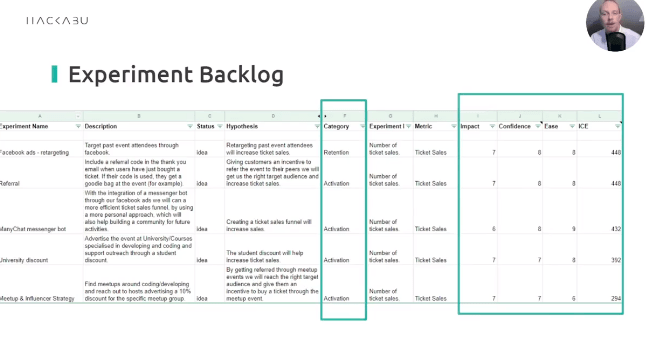Growth Marketing: From Framework To Experimentation in 90 Days
What is growth marketing?
Growth marketing starts with defining the single most important KPI for your business.
Then you follow the growth marketing process, which consists of the following six steps:
- Data Analysis
- Consumer Research
- Competitive Analysis
- Idea Generation
- Prioritization
- Experimentation
- Learning
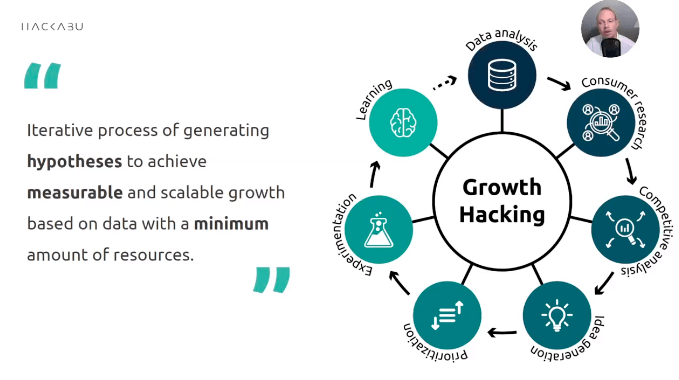
Growth marketing is about experimenting.
But the experiments aren’t just random; they always start with a clear hypothesis.
- Why do you think this experiment could work?
- What data – quantitative or qualitative – do you have as evidence?
- What metrics are going to be impacted?
After conducting your experiments, the most important outcome from it is learning. Seeing your experiment succeed is great, but the most important outcome is understanding what can help your company grow and what doesn’t. A failed experiment can be just as valuable as a winning one because it tells you where not to waste time in the future. Make sure that learnings from your experiments are stored somewhere so you can refer to them in the future.
Is growth marketing the right fit for your company?
There are four factors you need to consider when deciding if growth marketing is suitable for your company or not.
These are product-market fit, willingness and resources to test, a well-established growth process, and data. All four factors are interlinked.
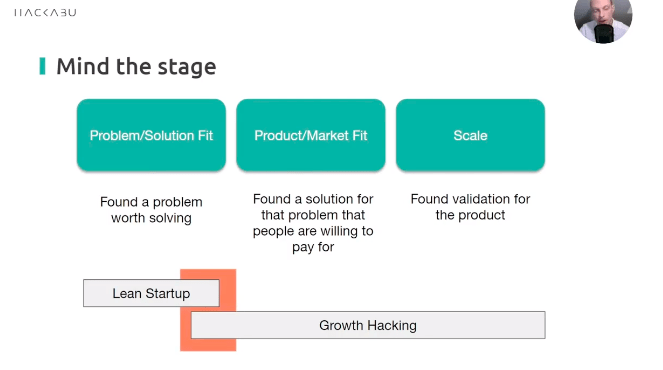
To get product-solution fit, focus on lean start-up methods: build something fast and get quick learnings to find a problem worth solving.
Before you start thinking about growth marketing, make sure you’ve reached product-market fit first.
- Have you found a problem worth solving?
- Have you found a solution that people are willing to pay for?
- Can you scale it?
The most effective teams who succeed at growth marketing have one thing in common: they have a growth mindset.
- They get encouraged by challenges and testing new things.
- They learn from failures and can welcome criticism.
So you have decided that your company is ready for growth marketing.
Here is a framework you can use for a 90-day growth plan:
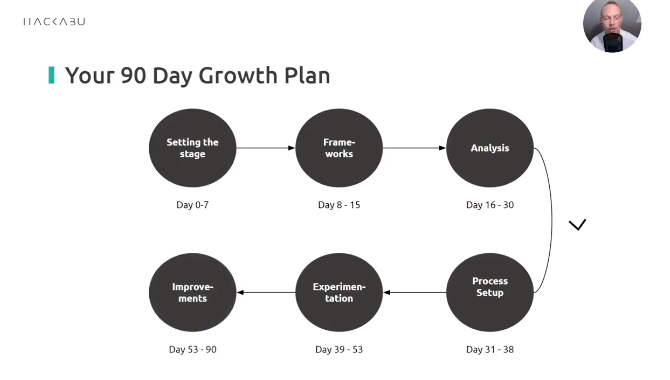
Steps to get started with growth marketing
1. Define your growth goals
To move forward, you must define what your goals for growth are. There are two sets of important goals – short and long-term:
The North Star Metric
This metric indicates your company’s growth; it encompasses your vision and is a long-term goal that sets the overall direction of your company
The One Metric That Matters (OMTM)
This refers to the metric that matters right now—for example, your sign-ups per day, conversion rate, acquisition cost, or your churn rate.
2 . Set the right metrics
To ensure you are setting the right metrics for your growth, you can use the (AAARRR) pirate funnel first popularized by Dave McClure.
In most companies, the first part of the pirate funnel – awareness and acquisition- is the responsibility of marketing. Product teams typically take care of activation, retention, and referral. Growth tears down these boundaries and looks at all of the stages of the funnel holistically.
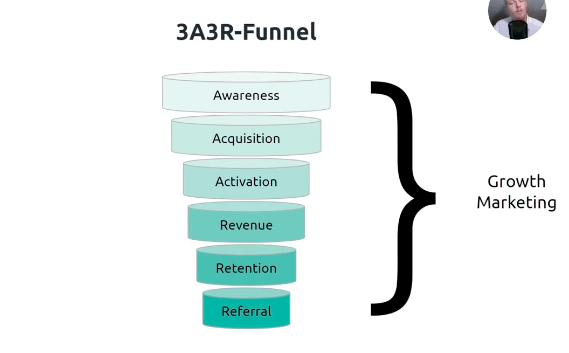
A good growth marketer looks at the funnel and decides where to optimize depending on the potential. They can work on driving traffic, get people to sign up, use the product in a meaningful way, become a long-term customer, and then refer others.
You need to track the number of people at every stage of the funnel. This helps you see where you have the most significant lever and can have the biggest impact. Analyze at each stage of your funnel how significant your drop-off is, so you can then go about improving it.
3. Finding the best traction channels
To find the channels suitable for your business, you can use the ‘Bullseye Framework.’ described in the book “Traction” by Gabriel Weinberg & Justin Mares.
Start with a list of 19 growth channels you can choose from. Think of ideas for each channel, then narrow down the most relevant six to your business.
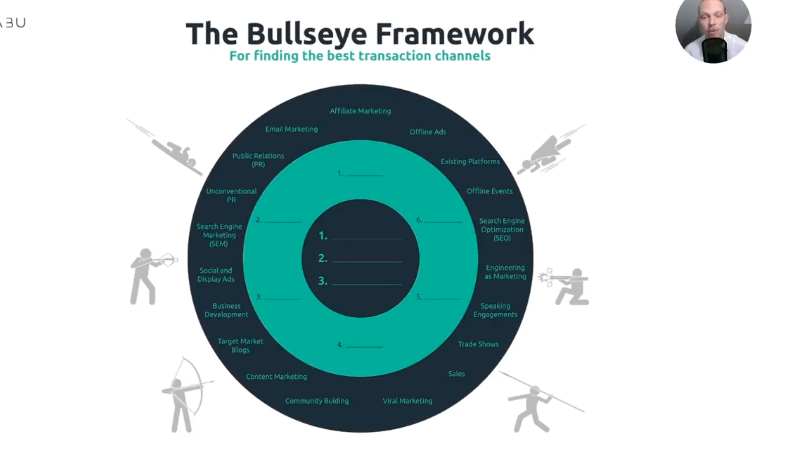
For example, suppose you are a mid-market SaaS business. In that case, community building, content marketing, and viral marketing are probably good channels for you, but business development and 1-1 acquisition perhaps not as they are labor-intensive and not as scalable.
Once you have decided on six channels to try, start some testing. Remember to have clear hypotheses on what you’d like to test and define clearly which metrics you’re trying to influence.
4. Keep an experiment backlog
For experiments to be functional, you need to track them carefully. Set up a proper structure with your project management tool. Growth Hackers Experiments is a great tool to manage your workflow, but you may also start with a spreadsheet.
How do you name the experiments, and how do you establish team alignment?
Keep a log of all your experiments so you can analyze what is working.
Here’s a framework you can use for experimentation:
As you can see, it describes the experiment and categorizes the funnel stage that we want to impact.
Once you have data to show you which stage of the funnel is most vital for you to focus on, go about prioritizing your experiments.
Use a scale such as the ICE score; this ranks the experiments by estimated impact, confidence (how certain are we this will work?), and ease (what time & resources are required to run the experiment?).
5. Growth analysis phase
Once you have collected data from your experiments, you need to analyze it to establish which channels are worth pursuing. To do this, there are two main areas of focus:
Customers
You need to create your ideal customer profile, and understand who your customer is. Talk to people, and conduct research.
Online tools are great, but nothing beats getting out of your office and talking to people – or at least virtually via Zoom.
Use Hotjar to check your website recordings to see when people drop off. This helps you understand your customer behavior and gives you ideas for future experiments.
Channels
Look at your online data to find out which channels have the most significant impact on specific metrics. Track the channels you’re going to use and the tool setup. Tracking needs to be implemented.
If you are successful with something, then automate it, and scale it. If it fails, capture the learnings. Hypothesize why it may have failed. Your successes and failures will help to generate new ideas constantly.
How to build an experimentation roadmap?
Here’s some advice on not making too many errors when building your experiment roadmap. Remember, some mistakes are inevitable and good!
These five mistakes are common amongst growth marketing teams:
Not testing the right KPIs
Want to increase the number of sign-ups by changing your homepage? The right KPI would be the number of people who clicked on the sign-up form rather than how many people didn’t fill the form. Have a clear intent when deciding what to measure.
Not taking internal resources into account
Don’t invest in things you don’t have the resources to execute. Evaluate your resources before deciding on an experiment. You may have an idea that sounds great on paper but don’t have the resources to run it.
Not having an established process for experimentation
Use the advice in this article to establish a tight process for the way you conduct experiments.
Not being flexible enough to make adjustments
You don’t just set up an experiment and forget it. It needs tweaks and adjustments regularly.
Not making significant enough changes
If you are a very young company, minor tweaks to your website will not cut it. Maybe you need to redo your homepage completely. Perhaps you need to rename your product. Be open to this.
Get started with growth marketing
Now you have some concrete steps to get started on your growth marketing journey.
Define your goals, track the right metrics and get experimenting!
